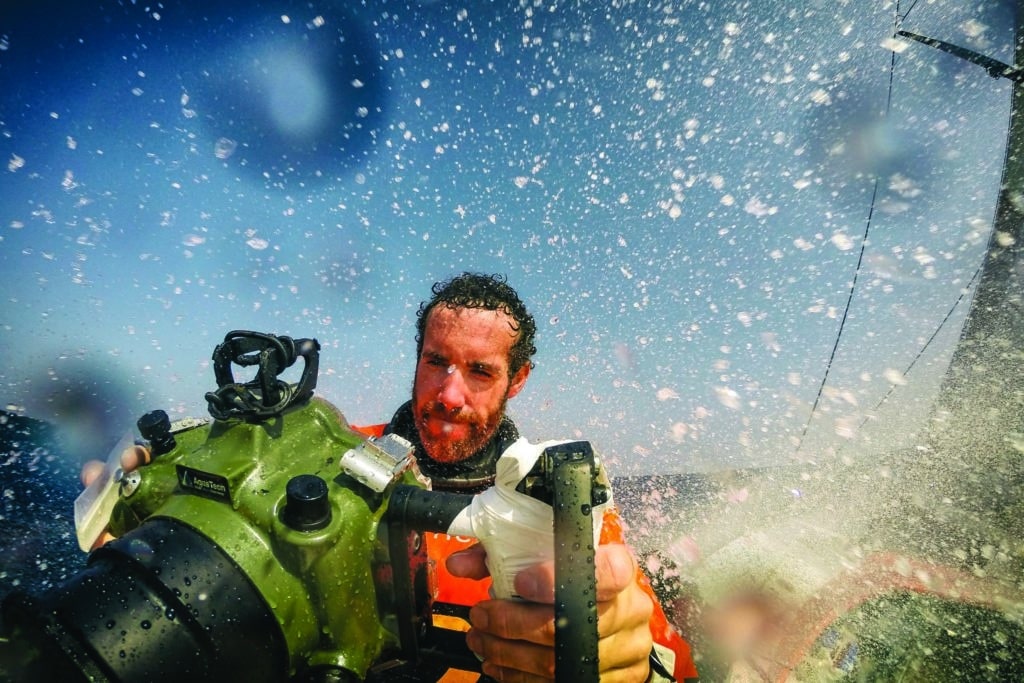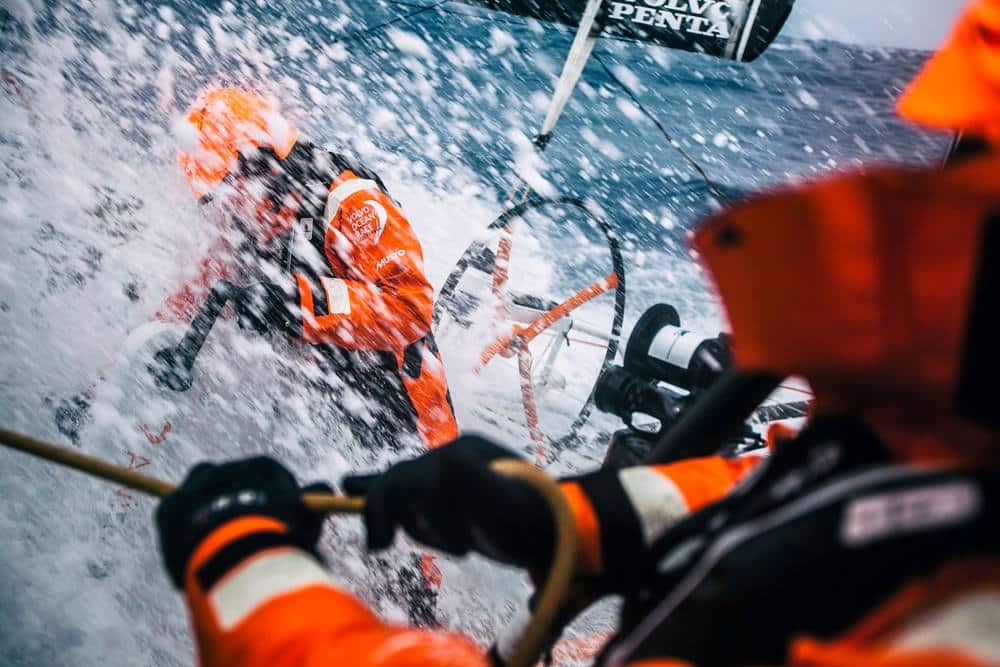
The day’s assignment is easy: file a short video story from on board Oakcliff Sailing Center’s Tuesday night match-race drills. With marching orders in hand, the half-dozen students enrolled in Oakcliff’s immersive five-day “Onboard Reporter” course shuffle out of the classroom with anticipation, eager to apply what they’ve been taught by the bearded master, Amory Ross, a two-time veteran of the Volvo Ocean Race’s embedded-reporter program.
On this day in late May, Ross stood before the class for nearly six hours, his vault of tips and tricks open for the students to raid. He’s dished out more than a decade’s worth of hard-earned advice on how and when to capture the fleeting moments of a sailboat race using photos, videos and words. Before heading off to the boats, the students prepare their equipment. A few of them have decent cameras and lenses and know how to use them, but the others have GoPros and iPhones to record and package the night’s story — whatever that may eventually be.
When we arrive at the dock, a short walk from the sailing center, Oakcliff’s white battle-worn 40-foot match-race boats rest motionless on their moorings. Long Island’s Oyster Bay is a glassy slate, reflecting steel-gray overcast skies that hint of rain. Warm zephyrs touch down but quickly vanish as they bounce off the cool spring water, leaving calm in their wakes. With little to no wind, these budding storytellers will have to get creative. A pair of students is assigned to each boat: one designated as producer and the other as cameraman. Together, they are to find and record a compelling story, edit it ashore after racing, and submit a finished project by 11 p.m. Ross and award-winning OBR Matt Knighton (who chronicled Abu Dhabi Ocean Racing’s VOR win) will critique their projects the following day.
Once off the launch, we get straight into rigging the boat: stripping the sailcovers, passing running rigging through ratchet blocks, hooking jib hanks, and casually bantering about the absence of wind. To my surprise, I observe our OBRs standing idly by at the back of the boat, cameras in hand. I sense they’re waiting for something to happen. But it’s all happening: the bustle of pre-race prep, the anticipation of a race. They’re missing what Ross has explained to them many times as essential material for the “intro.”
With sails hoisted, we coast off the mooring, setting the tired white spinnaker freckled with patches. It hangs limp and lame between the masthead and the outboard end of the long aluminum spinnaker pole. Our trimmer struggles to give the spinnaker any semblance of shape, sawing the sheet and guy through their ratchet blocks. Our OBRs stand near the transom, cameras still idle. I’m not sure they know what to shoot or where to move in the boat. Maybe they’re saving their memory cards for real action.

In this moment, an example of Ross’ comes to mind, about how he pieced together a story on something as mundane as the scorching heat of Leg 2 of the past Volvo Ocean Race. Shoot wide, then tight, he explained. Find a detail, something that clearly illustrates the moment. In the sample video he’d presented earlier in the day, one powerful detail was a split-second cameo of a whistling teapot spliced into the story. It perfectly illustrated the point: It was boiling hot inside the Volvo 65. For our OBRs, that same effect could have been found in a close-up crinkle of the draped spinnaker, a wake rippling off the transom, or simply a tight shot of the cassette tape drooping from the shroud.
With a weak 5-knot breeze, we start the first match of the night by entering the box late on port, as there’s much confusion about which flags mean what, where we are in the countdown sequence, and who’s doing what. We then glide off the starting line trailing astern of our match mate, eating the disturbed air spilling off the back of their sails. My ear catches the sound of the GoPro coming alive from the back of the boat. I hear camera clicks, but still, the OBRs are rooted in the boat’s stern scoop. From their vantage point, I think, they will capture the backs of heads. A story needs faces. I’m tempted to advise them to move about the boat for different perspectives, but I resist. They must have their creative plan. Ross schooled them well, to be alert and mobile, to anticipate the action, to be aware and in tune with everything happening around them. To act, not react.
As his own example of anticipation during the day’s earlier classroom session, Ross had told the story behind when Alvimedica stood by Team Vestas Wind after Vestas ran aground on Leg 2 of the Volvo Ocean Race. Once the sat phone rang on board Alvimedica, said Ross, he knew something dramatic was about to unfold. He didn’t sleep for 24 hours as he stood OBR vigil over Alvimedica’s veteran navigator, Will Oxley, who relayed the communications between the stricken crew and race headquarters in Spain. Ross documented every conceivable element of the event, focusing on Oxley, he said, because he knew he was the central character of the story. His instincts were right, and the result was one of his proudest pieces of storytelling.
As Ross guided the students through the story’s edits, he explained the building blocks again: start with an opener that provides context, pan, go tight, go wide, provide perspective, tell the story, and close with an “outro.”
We reach the weather mark two lengths behind the lead boat, and as our fate appears sealed, I recommend we jibe in the direction of a puff that has touched down a stone’s throw away, to starboard. But by the time the lead boat responds, it’s too late. We’re the first to take a bite of the gust, and squirt forward before the spinnaker hangs limp again.
The outbound current on our bow is sweeping us away from the line, however, and our tactics become anxious and uncertain. I suggest we drop the spinnaker and switch to the jib. Everyone agrees. Our bowman springs into action, drops the pole to the deck with a dense metallic thud, and hoists the jib with swift hand-over-hand pulls. The jib’s metal hanks zip up the forestay. It’s a cacophony, the most excitement of the night, and maybe even the winning move of the race, but again, I glance back toward the OBRs watching the action unfurl. I think to myself: “I can’t believe they missed that, too. Amory would be so disappointed.”
We win the race on account of luck more than anything else, but the result means nothing. It’s a drill, conducted for the benefit of the OBRs to apply their classroom knowledge. A light-air drifter can be as comical and dramatic as a big-breeze sleigh ride, so I’m curious to see what the OBRs deliver for the following morning.
Some were good; I’d wholly underestimated our onboard chroniclers. In fact, they were smarter than I would have been, heeding Ross’ advice: “Don’t just shoot to shoot.”
Although Ross’ job is safe, Oakcliff’s initiative is a tremendous start for those keen to go to sea and immortalize what happens out of sight. Offshore sailing desperately needs more OBRs because only through great storytelling and powerful visuals can we inspire others to join our ranks, to race across oceans and around the buoys so we can vicariously race alongside them. The Volvo Ocean Race touts its OBR role as “the toughest job in sports journalism,” and that’s not an exaggeration.









